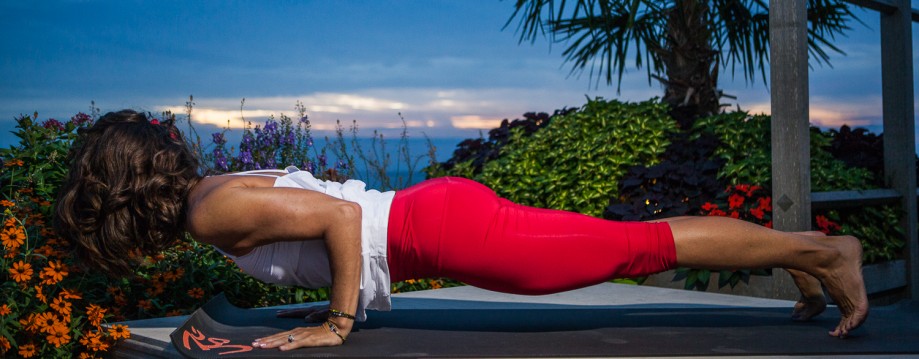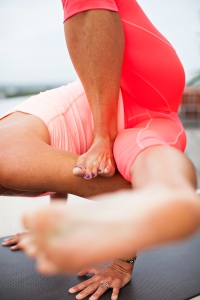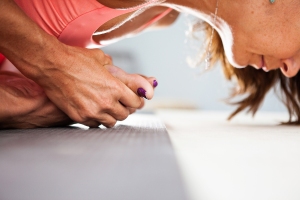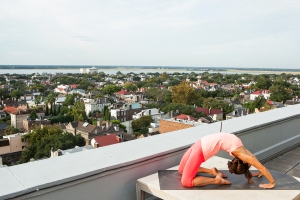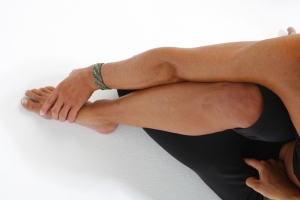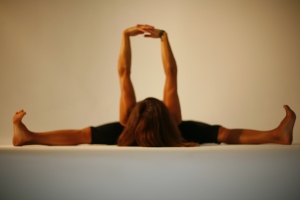Yoga has succumb to the fast food influence. Everyone wants the cool poses and they want the cool poses NOW! People would also like to pay as little as possible for their time spent doing these trick postures. These circus trick postures seem to be as tempting as the little plastic super hero figurine in a happy meal. The “high” from these postures is addictive, and it has power that can alter your life. But not all things we do are good for us. The surgeon general warns us that cigarette smoking is bad, yet people still do it. So what are we to do when we feel tempted to only be pleasure seekers and pain avoiders? Always start with awareness.
We have gone mad with yoga in the United States with classes called happy hour, wisdom warriors and rockasana. These classes branded with big promises of happiness, knowledge and the “Cool” factor. If anything, when I head to a yoga class I am usually looking for less, not more. I want to walk away feeling liberated of the heavy load I’m carrying. I don’t want to worry about how cool I look, while losing a percentage of my hearing because I’m jamming out to Eminem in Triangle pose. What has happened to yoga in America? In my opinion, it has just become another thing we have tried to control, stamp a label on, and declare it ours. Now let’s see how cheap we can make it, how trendy and nutritionally devoid. Sounds a lot like fast food doesn’t it?
Now I don’t want to be the Grinch that stole Natarajasana from the towns people, but I wouldn’t mind stealing a few things away from this Americanized yoga. Like Loud music, cute little names for the postures (like fallen angel and baby grasshopper), lavender-scented hand towels, foot rubs in savasana, and arm balances. Now hear me out, I know I few of you just gasped; If you like loud music, listen to it in your car on the way to yoga because it’s not possible to listen to your breathing in a Rockasana class. Which is the primary tenet of yoga’s methodology. If you like foot rubs, pay a trained massage therapist to assist you in your healing. If you like lavender-scented towels then launder your clothes with a little lavender added to it. Remember the 4th limb of yoga Pratyahara – sense withdrawal, not sense overload. And if you like your practice to have a heavy portion of arm balancing, this could be a good time to examine why? Has your yoga become a place for an addiction? Is this kind of yoga possibly feeding narcissism?
I know arm balancing postures are very empowering! I’m not trying to say that they have no place in yoga, as they have many benefits, different for each student. I’m not saying that we should take any of these things I speak of away from the students. But teachers should ask the question “Am I teaching this class to be popular? to be famous? to fill my ego and get my number of followers to a million on social media?” or “Am I teaching it for the people who show up? Evaluating their ability and analyzing their patterns of weakness and or stubbornness. Is it for me, or is it for them?” No doubt there is a “high” that can come with being up at the front of the room demonstrating great skill in front of 40 people, their eyes wide from being enamored by your grace and beauty. It is this “high” we must be careful with. I took a great workshop from Sean Corne, a very beautiful and gifted teacher. She said, “do you want to be popular, or do you want to be a good teacher?” That question has always stuck with me through 14 years of teaching. I try to check my motive behind my teaching with that question. Sometimes you have to sacrifice the trick poses so that you can teach an intelligent sequence that informs and educates as you go.
Some teachers do a beautiful job, sequencing, cueing and supporting the student, but too many times I have seen the opposite – where 80% of the students are at a basic level ability, but the teacher is handing out advanced level postures. 20% of the students achieve the asana, 50% are plain sitting it out, 10% are putting in good effort and 20% are setting up patterns of future injury. This is not good teaching. I believe the source of this kind of teaching has to do with the fast nature of the industry now. Yoga studios are graduating large groups of trainees every couple of weeks. This side of the industry is becoming like an assembly line. The fact is that you can get certified to teach yoga in 1 month, accumulating as little as 200 hours of knowledge, and in the end all you have to do is pay your 95$ to Yoga Alliance. Which only proves you finished the training. It proves nothing of your knowledge or commitment. Graduates do not have to take a test, or submit competency of any kind to the governing body of yoga. This seems like a slippery slope for yogas future.
In traditional ashtanga yoga, a teacher can hold you back from future postures until you have done the work necessary to move your body into and out of it in a safe and appropriate way. This is just one of the reasons why I love Ashtanga and its old school principals. There is nothing wrong with taking things slow. I love that my Ashtanga yoga teacher, who I greatly respect, doesn’t even offer a 200 hr course. He offers instead two separate 100 hour trainings and they are spaced a year apart. This helps to ensure that the student stick with it for at least a year. It proves a teacher’s level of dedication when they are willing to wait, continue to practice and come back a year later to complete the course.
Now a days, a student can start yoga in February, practice on and off for a couple of months, take a 1 month teacher training, and maybe a few months later they open their own studio and begin teaching something that they have only just begun. This would be like opening a restaurant because you own some cook book’s. Or opening a doctor’s office because you are really proficient at taking temperatures, and giving boo boo’s kisses. There is a reason why so many professions take years of schooling. Many have boards that you must pass before you can practice your profession. It’s the reason why restaurants receive reviews from the board of health, to help prevent you from getting bad food. Who is going to protect the public from getting bad yoga?
Change will come when people no longer want it fast and cheap. When they decide to no longer be glazed over by the shiny big promises of the cool poses and fancy tricks, but start to enjoy the simplicity of what yoga can do for you – like a better nights sleep. Maybe it’s time to teach “bran muffin-nutritionally packed” kind of yoga, with thoughtfulness to the actual students that show up and organized progressively towards a specific posture. Instead of teaching a “donut-empty of nutrients” kind of class, devoid of any substantial thought and or observation to the students participation and progression. These kind of classes that has as many arm balances thrown in as possible, with each one behaving like a sugar spike the way nutritionally devoid food behaves. These sugar spike postures are bound to create a big crash, or as I have seen – a real crash to the very hard and unforgiving floor.
Yoga is a lifelong journey that requires time on a yoga mat – alone and with a professional teacher. It requires time to digest and adapt the information. It requires the student making wise choices to practice with qualified teachers who have done their time on the mat. So don’t be afraid to ask your teacher qualifying questions like “How long have you been teaching?”, or “With whom have you studied?” There are enough qualified, elder and senior teachers out there – with more than 10/15 years teaching experience. You don’t have to settle for the studio that is the closest, the cheapest, or even the fanciest. That could be buying you yoga devoid of any expertise.
Keep your awareness sharp and make sure you aren’t falling for nutritionally empty yoga. Be ware of gimmicks. Play with those postures within reason. Stay aware of some of the poisons there are in a yoga practice like aversion and attachment.
When are you an addict? When you are so attached to something that it causes you great suffering to go without. It’s easy to get addicted to just about anything. By constantly re-examining your motives you will keep your addictions in check. Go for sustenance, commit to the long haul and enjoy the subtle flavorings of a good practice with a very qualified teacher. Sometimes the best flavors come out of a long slow cooking process. Soak in the wisdom from the years some of these teachers have invested. Be willing to let your yoga progress slowly at times. A good teacher will help you do that by calling you out on your aversions, and your attachments. And always try to remember this simple advice from the yoga sutra’s.
Sutra 1.12 Abhyasa Vairagyabhyam Tannirodhah. Mental fluxes are restrained by practice and non-attachment
Sutra 1.14 Sa tu dirgha kale nairantarya satka-rasevito drdhabhumih. Practice becomes firmly grounded when well attended to for a long time, without break and in all earnest.
Sutra 2.3 Avidyasmita raga dvesabhinivesah klesah – There are five primal causes of suffering: ignorance of your True Self and the value of spirituality, egoism and its self-centeredness, attachment to pleasure, aversion to pain, and clinging to life out of fear of death.
